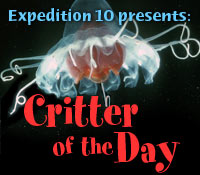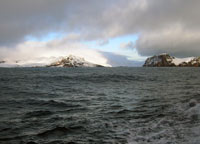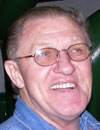|
  Today's Weather Sunny Lat: 62 42.26 S Long: 64 26.15 W Wind: 23 KT Sea State: 5 Swell Height: 6-8 Baro Pressure: 992.0 mB Air Temp: 3.5°C Sea Surface Temp: 3.1°C Vis: 8 NM 
  Read the new Hot Topic: Deception Island: Fire and Ice, History and Humans  Read the acrostic poems submitted by Mary Cook's class from Batesville, Arkansas March 10, 2006 by Kate Madin Expedition 10 and this cruise are winding down—only two more days before we have to start packing. From the vans storing the LAPIS and diving gear to the test tubes and all the preserved samples—all of it must be packed before we start across the Drake Passage where seas can be too rough to work. What have we accomplished during this hectic time? The researchers will spend months analyzing data and then will publish results of their studies in journals or share them with other scientists at scientific meetings. But they have some early results and ideas from this cruise. We have done three kinds of work here:
Pat Kremer studied how much food was in salps’ guts and how long it took them to digest it. “For me,” she said, “one of the important accomplishments of this cruise was the determination of the salps’ digestive time”—the time it takes to consume food, digest it, and move it out of their bodies as fecal pellets. “This means we can tell how much food the larger population of salps takes in. This can help reveal the population’s feeding impact on the ecosystem here.” Jun Nishikawa used the net tows to tell where the salps were over the course of a 24-hour day. He found that the salps migrated up toward the surface and back down to lower depths, and they changed their migration patterns when characteristics of the water (temperature, salinity, or oxygen levels at different depths) changed. The salps “seem more flexible here,” he said. Larry Madin studied how fast salps reproduce and grow and also tested his prototype instrument, LAPIS, with Erich Horgan and Josh Eaton. “We learned a lot about the life history, biology, and energy use of Salpa thompsoni that no one knew before,” he said, “including how big they are when born and the differences in reproduction rate between early spring and late summer populations. We also learned that LAPIS creates excellent real-time images of living gelatinous plankton while towed in deep water.” Graduate students did research for their degrees and took samples for future projects. Volunteers took on lab experiments, diving, and record keeping. Divers dove and collected salps for experiments. Everyone worked well together. It’s been a successful science cruise. Thanks and Acknowledgements
Read the interview
|
|||||||||||||||||||||||||||||||||||||||||||||||||||||||||||||||||||||||||||||||||||||||||||||
Mailing List | Feedback | Glossary | For Teachers | About Us | Contact
© 2010 Dive and Discover™. Dive and Discover™ is a registered trademark of Woods
Hole Oceanographic Institution

 The Gould’s Chief Engineer Paul Waters, from North Carolina, loves his work, and intimately knows all the ship’s systems. This interview took place during a tour through the engine room.
The Gould’s Chief Engineer Paul Waters, from North Carolina, loves his work, and intimately knows all the ship’s systems. This interview took place during a tour through the engine room.